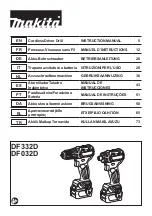
9
KEYLESS CHUCK - FIGURE 5
To insert a drill bit or other accessory:
Loosen the chuck (D) by rotating the sleeve counterclockwise. Insert the bit or other
accessory fully into the chuck, and tighten securely by rotating in the clockwise direction
as viewed from the chuck end.
WARNING:
Do not attempt to tighten drill bits (or any other accessory) by gripping the
front part of the chuck and turning the tool on. Damage to the chuck and personal injury
may occur when changing accessories.
DUAL RANGE GEARING - FIGURE 6
The dual range feature allows you to shift gears for greater versatility.
• To select low speed, high torque setting (position 1), turn tool off and permit to stop. Slide
gear shifter button (I) back (away from chuck).
• To select the high speed, low torque setting (position 2), turn tool off and permit to stop.
Slide gear shifter button forward towards the chuck.
NOTE:
Do not change gears when
tool is running. If you are having trouble changing gears, make sure that the gear shifter
button is either completely pushed forward or completely pushed back.
SCREW DRIVING
For driving fasteners, the reversing button should be pushed to the left. Use reverse
(button pushed to the right) for removing fasteners. When moving from forward to reverse,
or vice versa, always release the trigger switch first.
DRILLING
• Use sharp drill bits only.
• Support and secure work properly, as instructed in the Safety Instructions.
• Use appropriate and required safety equipment, as instructed in the Safety Instructions.
• Secure and maintain work area, as instructed in the Safety Instructions.
• Run the drill very slowly, using light pressure, until the hole is started enough to keep the
drill bit from slipping out of it.
• Apply pressure in a straight line with the bit. Use enough pressure to keep the bit biting
but not so much as to stall the motor or deflect the bit.
•
Hold the drill firmly with two hands to control its twisting action.
• DO NOT CLICK THE TRIGGER OF A STALLED DRILL OFF AND ON IN AN ATTEMPT
TO START IT. DAMAGE TO THE DRILL CAN RESULT.
• Minimize stalling on breakthrough by reducing pressure and slowly drilling through the
last part of the hole.
• Keep the motor running while pulling the bit out of a drilled hole. This will help reduce
jamming.
• Use a cutting lubricant when drilling metals. The exceptions are cast iron and brass which
should be drilled dry. The lubricants that work best are sulphurized cutting oil or lard oil.
• When using twist drill bits to drill holes in wood, it will be necessary to pull the bits out
frequently to clear chips from the flutes.
•
Make sure switch turns drill on and off.
DRILLING IN WOOD
Holes in wood can be made with the same twist drill bits used for metal or with spade bits.
These bits should be sharp and should be pulled out frequently when drilling to clear chips
from the flutes.
DRILLING IN METAL
Use a cutting lubricant when drilling metals. The exceptions are cast iron and brass which
should be drilled dry. The cutting lubricants that work best are sulfurized cutting oil or lard oil.
DRILLING IN MASONRY
Use carbide tipped masonry bits. Refer to Drilling section. Keep even force on the drill but
not so much that you crack the brittle material. A smooth, even flow of dust indicates the
proper drilling rate.
90543725 HP18V 10/10/08 1:31 PM Page 9










































